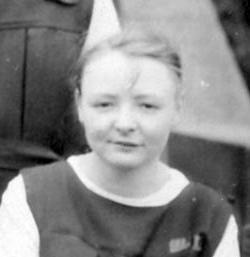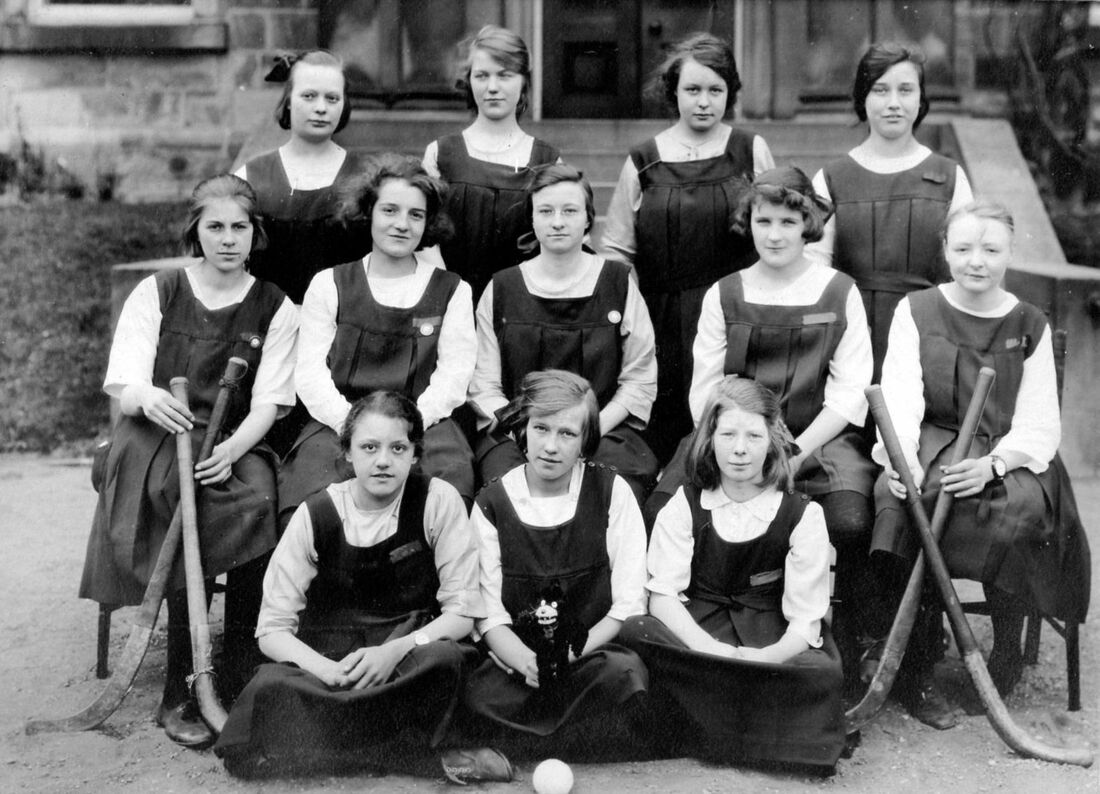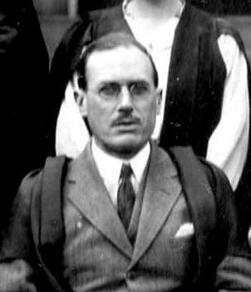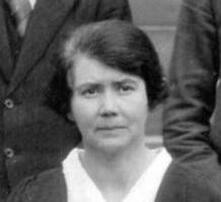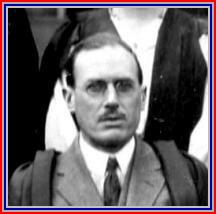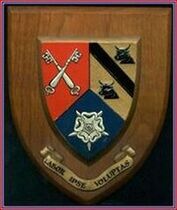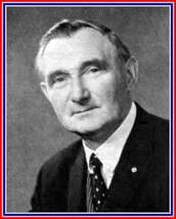The Marion Finch Story
Hemsworth Secondary School 1921-1925
Hemsworth Secondary School 1921-1925
Launched at last
My parents decided rather late that their family was growing up, so Norah and I were sent to school in Wakefield. Our education was very expensive so we were very lucky we were able to go. At least, that was what we were told. I wasn’t so sure. We started at the school in 1920. The fees alone were seven guineas per person per term and there were lots of extras to pay for apart from the uniform. There were train passes to buy and dinner tickets too. We had to provide all our own text books and exercise books. We managed to buy our text books at Fowler’s Second Hand Book Shop in Kirkgate. We bought the stationery, pens, pencils, etc at the Eagle Press in Wood Street. Games and music were also extras so it must have cost my parents quite a lot of money.
I cannot answer for my sister but I didn’t appear to learn anything except: how to hang up my hat with the badge underneath to avoid soiling; not to eat sweets in the street and always to walk to and from school along Back Lane and never through town. During the winter we wore navy velour hats but in the summer term we wore straw boaters. It was quite embarrassing walking through Hemsworth wearing one. Molly, one of the girls who travelled with us on the train was rather plump and very jolly, her head used to sweat and, consequently, the crown of her straw hat peaked at the top instead of remaining flat which amused us but embarrassed Molly very much.
On school mornings we were roused at 6.30 am and left home by 7.30 to catch the 8 o’clock train. We had quite a long walk to Hemsworth station from Barnsley Road but we always had plenty of time to play about on the platform. We would ask for rides on the crude lift which was really only used for goods. This lift was worked manually. Some of the lads using the train could be seen leaping down the steps to the platform just as the train was about to move off. They managed to catch the train by the skin of their teeth. Kathleen, who travelled with us trapped her fingers in the carriage door and they were quite sore. Someone on the platform must have seen this and of course took the news to her mother. The mother had fretted and worried all day and was in quite a state when we all arrived back by the four o’clock train. The outcome was that Kathleen’s mother banned her from travelling with the rest of us. We hadn’t had anything to do with the accident but her mother would not believe us.
Many a time I’ve walked up Station Hill (it doesn’t seem so steep these days) helping Tommy Shelton to push his handcart loaded with frozen game and fish he’d been to pick up from the station. Sometimes I helped old Mr Hodgkins, the postman, to push his barrow full of mail he’d been to pick up too. Norah was always home much sooner than me. I was thirteen years old and Norah was fourteen years old when we began our first term at High School. Because of our age, we were put into the fourth form. We were like fish out of water. The rest of the class had already been taught the basics of Maths and French. The French mistress, Miss Mathews, used to breeze into class chanting a string of words (unintelligible to me and my sister) which caused some girls to stand up and sit down, open windows and close doors etc. We both gave up on Maths and French. Maths had been a very weak subject in our previous school. The Xs and Ys of algebra seemed to have a mystical meaning for us and we had no idea how to deal with them. I think the teacher must have given us up as hopeless because we were never enlightened. This state of affairs mercifully came to an end when, in 1921, the West Riding Education Authority opened Hemsworth Hall for secondary education.
My parents decided rather late that their family was growing up, so Norah and I were sent to school in Wakefield. Our education was very expensive so we were very lucky we were able to go. At least, that was what we were told. I wasn’t so sure. We started at the school in 1920. The fees alone were seven guineas per person per term and there were lots of extras to pay for apart from the uniform. There were train passes to buy and dinner tickets too. We had to provide all our own text books and exercise books. We managed to buy our text books at Fowler’s Second Hand Book Shop in Kirkgate. We bought the stationery, pens, pencils, etc at the Eagle Press in Wood Street. Games and music were also extras so it must have cost my parents quite a lot of money.
I cannot answer for my sister but I didn’t appear to learn anything except: how to hang up my hat with the badge underneath to avoid soiling; not to eat sweets in the street and always to walk to and from school along Back Lane and never through town. During the winter we wore navy velour hats but in the summer term we wore straw boaters. It was quite embarrassing walking through Hemsworth wearing one. Molly, one of the girls who travelled with us on the train was rather plump and very jolly, her head used to sweat and, consequently, the crown of her straw hat peaked at the top instead of remaining flat which amused us but embarrassed Molly very much.
On school mornings we were roused at 6.30 am and left home by 7.30 to catch the 8 o’clock train. We had quite a long walk to Hemsworth station from Barnsley Road but we always had plenty of time to play about on the platform. We would ask for rides on the crude lift which was really only used for goods. This lift was worked manually. Some of the lads using the train could be seen leaping down the steps to the platform just as the train was about to move off. They managed to catch the train by the skin of their teeth. Kathleen, who travelled with us trapped her fingers in the carriage door and they were quite sore. Someone on the platform must have seen this and of course took the news to her mother. The mother had fretted and worried all day and was in quite a state when we all arrived back by the four o’clock train. The outcome was that Kathleen’s mother banned her from travelling with the rest of us. We hadn’t had anything to do with the accident but her mother would not believe us.
Many a time I’ve walked up Station Hill (it doesn’t seem so steep these days) helping Tommy Shelton to push his handcart loaded with frozen game and fish he’d been to pick up from the station. Sometimes I helped old Mr Hodgkins, the postman, to push his barrow full of mail he’d been to pick up too. Norah was always home much sooner than me. I was thirteen years old and Norah was fourteen years old when we began our first term at High School. Because of our age, we were put into the fourth form. We were like fish out of water. The rest of the class had already been taught the basics of Maths and French. The French mistress, Miss Mathews, used to breeze into class chanting a string of words (unintelligible to me and my sister) which caused some girls to stand up and sit down, open windows and close doors etc. We both gave up on Maths and French. Maths had been a very weak subject in our previous school. The Xs and Ys of algebra seemed to have a mystical meaning for us and we had no idea how to deal with them. I think the teacher must have given us up as hopeless because we were never enlightened. This state of affairs mercifully came to an end when, in 1921, the West Riding Education Authority opened Hemsworth Hall for secondary education.
1921 - Hemsworth Secondary School is founded
Norah and I left the Wakefield Girls High School and started here in Hemsworth along with many other girls who had been fellow travellers to the Wakefield Girls High School. We were placed in the fourth form which was the highest form at that time. The good thing about starting again was that we all started from scratch. The subjects that had puzzled us so much were well taught and we began to see the light.
From the first day of starting at Hemsworth Secondary School, education began to mean something to me and I loved every minute of it. Well nearly every minute. I remember wishing I could faint or turn sick instead of attending one particular French lesson. Of course, I’m one of those people who never pass out to order. I always looked the picture of health, so I had to attend and endure. Norah and I must have learned something from our short stay at Wakefield as we always managed to hold our own in class.
Hemsworth Hall was opened as a secondary school in September 1921. As far as I can remember, very little if anything was done to the original building. The classrooms were heated with coal fires - not very warm for pupils sitting at the back of the room. The staff consisted of a headmaster, two male and two female teachers so you can imagine how small the school was to begin with. The headmaster, Mr Jenkinson, had been a major in the forces and he was a very strict but fair disciplinarian. The rest of the staff consisted of Mr Dickinson for maths and science, Mr Cleft for geography and the women teachers, Miss Prince and Miss Jackson, took English and French etc.
There were about 98 pupils when the School opened. There was no gymnasium and very little apparatus. We had a few balls, bean bags, hoops and skipping ropes. One room was fitted out as a laboratory for chemistry and physics. I remember there were different types of thermometers, bunsen burners, pipettes, test tubes, bell jars and glass tubing. I remember we worked in pairs trying to make a thermometer. My glass tubing always managed to shatter and we chased mercury all along the bench tops. Mr Dickinson was in charge of the laboratory, this made our lessons more tolerable. Altogether, the laboratory was a Heath Robinson affair. A room upstairs was set aside for PE and country dancing. One day, as we were in the middle of ‘Gathering Peascods’, an urgent knocking could be heard on the door, the floor rocked with our dancing and the messenger said that the ceiling was in danger of collapsing on to the floor below. This put an end to dancing upstairs. Although this was a mixed school, we girls were kept apart from the boys except in the classrooms. We had our separate entrances, cloakrooms and staircase. We were not allowed to run along the corridors but always to walk in single file, quietly. In the classrooms, the boys always made for the desks furthest away from the windows where it was cold. Our desks were single with a tip up lid and space for storing our books etc. I dread to think what else some of us stored in there.
Pupils came to our school from all the surrounding villages: South Hiendley, Brierley, Shafton, Grimethorpe, South Kirkby, South Elmsall, Upton, Ackworth, Nostell and Badsworth. There were very few buses and pupils walked from Hiendley and Brierley every day staying at school for their midday meal. The children from South Elmsall came by train to Hemsworth Station and entered the school grounds from the Station Road end. They also stayed for dinner. The local pupils went home for their midday meal. This new school was a God-send for the district. It provided opportunities for children who would have otherwise been denied. The cost for fee paying pupils was 2 guineas per term, rising later to 3 guineas. This enabled my parents to send more of the family as soon as they were old enough. At one time, I think there were five sisters, including me, from our family attending the Hemsworth Secondary School.
Norah and I left the Wakefield Girls High School and started here in Hemsworth along with many other girls who had been fellow travellers to the Wakefield Girls High School. We were placed in the fourth form which was the highest form at that time. The good thing about starting again was that we all started from scratch. The subjects that had puzzled us so much were well taught and we began to see the light.
From the first day of starting at Hemsworth Secondary School, education began to mean something to me and I loved every minute of it. Well nearly every minute. I remember wishing I could faint or turn sick instead of attending one particular French lesson. Of course, I’m one of those people who never pass out to order. I always looked the picture of health, so I had to attend and endure. Norah and I must have learned something from our short stay at Wakefield as we always managed to hold our own in class.
Hemsworth Hall was opened as a secondary school in September 1921. As far as I can remember, very little if anything was done to the original building. The classrooms were heated with coal fires - not very warm for pupils sitting at the back of the room. The staff consisted of a headmaster, two male and two female teachers so you can imagine how small the school was to begin with. The headmaster, Mr Jenkinson, had been a major in the forces and he was a very strict but fair disciplinarian. The rest of the staff consisted of Mr Dickinson for maths and science, Mr Cleft for geography and the women teachers, Miss Prince and Miss Jackson, took English and French etc.
There were about 98 pupils when the School opened. There was no gymnasium and very little apparatus. We had a few balls, bean bags, hoops and skipping ropes. One room was fitted out as a laboratory for chemistry and physics. I remember there were different types of thermometers, bunsen burners, pipettes, test tubes, bell jars and glass tubing. I remember we worked in pairs trying to make a thermometer. My glass tubing always managed to shatter and we chased mercury all along the bench tops. Mr Dickinson was in charge of the laboratory, this made our lessons more tolerable. Altogether, the laboratory was a Heath Robinson affair. A room upstairs was set aside for PE and country dancing. One day, as we were in the middle of ‘Gathering Peascods’, an urgent knocking could be heard on the door, the floor rocked with our dancing and the messenger said that the ceiling was in danger of collapsing on to the floor below. This put an end to dancing upstairs. Although this was a mixed school, we girls were kept apart from the boys except in the classrooms. We had our separate entrances, cloakrooms and staircase. We were not allowed to run along the corridors but always to walk in single file, quietly. In the classrooms, the boys always made for the desks furthest away from the windows where it was cold. Our desks were single with a tip up lid and space for storing our books etc. I dread to think what else some of us stored in there.
Pupils came to our school from all the surrounding villages: South Hiendley, Brierley, Shafton, Grimethorpe, South Kirkby, South Elmsall, Upton, Ackworth, Nostell and Badsworth. There were very few buses and pupils walked from Hiendley and Brierley every day staying at school for their midday meal. The children from South Elmsall came by train to Hemsworth Station and entered the school grounds from the Station Road end. They also stayed for dinner. The local pupils went home for their midday meal. This new school was a God-send for the district. It provided opportunities for children who would have otherwise been denied. The cost for fee paying pupils was 2 guineas per term, rising later to 3 guineas. This enabled my parents to send more of the family as soon as they were old enough. At one time, I think there were five sisters, including me, from our family attending the Hemsworth Secondary School.
Country Dancing
Mr Jenkinson, our headmaster, was a fanatic where country dancing was concerned. The whole school practised country dancing for weeks in preparation for the annual country dancing festival to be held on the sports field. On the afternoon of the appointed day, girls and boys gathered on the forecourt. There were many blushes and hopes dashed as the boys and girls paired up. Ceremonies began with the Helston Furry as we danced our way up to the games field led by a local brass band. Primary and secondary schools from districts round about were invited to join in. Once on the sports field, where parents and spectators were gathered, we formed a huge circle for Sellinger’s Round. Other dances followed but the climax came when the staff, including the headmaster, gave a Morris Dancing display. The men were dressed in white flannels and shirts tied up with coloured braids and bells and carried sticks. The sword dance where all the swords were woven into a star and carried aloft, was a great success judging by the applause. Judging from the crowds and the applause, the country dancing festival was a huge success.
Mr Jenkinson, our headmaster, was a fanatic where country dancing was concerned. The whole school practised country dancing for weeks in preparation for the annual country dancing festival to be held on the sports field. On the afternoon of the appointed day, girls and boys gathered on the forecourt. There were many blushes and hopes dashed as the boys and girls paired up. Ceremonies began with the Helston Furry as we danced our way up to the games field led by a local brass band. Primary and secondary schools from districts round about were invited to join in. Once on the sports field, where parents and spectators were gathered, we formed a huge circle for Sellinger’s Round. Other dances followed but the climax came when the staff, including the headmaster, gave a Morris Dancing display. The men were dressed in white flannels and shirts tied up with coloured braids and bells and carried sticks. The sword dance where all the swords were woven into a star and carried aloft, was a great success judging by the applause. Judging from the crowds and the applause, the country dancing festival was a huge success.
Games, Sports Days etc
The Grammar School was well endowed with spacious grounds and playing fields. Games were played regularly. The girls played either netball or hockey. I played hockey and enjoyed it very much. We had no protective clothing and wore just the school gym slips and gym shoes. We had no shin pads or hockey boots so we took many a hard knock on our shins with the sticks or ball. One girl in particular was very aggressive and if she couldn’t get at the ball she swiped our legs with her hockey stick. I kept as far away from her as possible. To this day I carry notches down the front of my legs caused by blows from hockey sticks. I was placed in the first team as left full back. I remember Margaret Foster was the right full back and I think Mary Hodgson was the goalkeeper. We enjoyed inter-school games on Saturday mornings, especially the away games as we enjoyed the refreshments provided for us after the game. I did not play much netball.
The Grammar School was well endowed with spacious grounds and playing fields. Games were played regularly. The girls played either netball or hockey. I played hockey and enjoyed it very much. We had no protective clothing and wore just the school gym slips and gym shoes. We had no shin pads or hockey boots so we took many a hard knock on our shins with the sticks or ball. One girl in particular was very aggressive and if she couldn’t get at the ball she swiped our legs with her hockey stick. I kept as far away from her as possible. To this day I carry notches down the front of my legs caused by blows from hockey sticks. I was placed in the first team as left full back. I remember Margaret Foster was the right full back and I think Mary Hodgson was the goalkeeper. We enjoyed inter-school games on Saturday mornings, especially the away games as we enjoyed the refreshments provided for us after the game. I did not play much netball.
The first Hockey team formed in 1922
Sports days were always popular and lots of time was spent out in the fields running heats. I wasn’t much good as a runner but in spite of that I was chosen to run in the inter-house relay races. There were no prizes, just points allocated to our respective houses. The overall winner with the highest number of points became Victrix/Victor Ludorum. It was a close fight between the houses and if our house came out on top we were extremely excited. Parents were able to come to sports day and there was always a parents’ race. Sports days were social events in Hemsworth and always well attended.
Reward and Punishment
There was a system of reward and punishment throughout the school. Stars were given for good work and stripes for misbehaviour. The stars were issued in quarters; not so the stripes. Punishment was doled out by the headmaster when the pupil had collected five stripes. The boys received corporal punishment but the girls were detailed to walk round the forecourt in full view of the headmaster’s study. This took place during break for a whole week. When there were several girls ‘walking’, they were evenly spaced so that they could not talk to one another - very embarrassing. We kept a record of our stars on a pink slip which was torn from a book similar to a cheque book. This pink slip had four lines on which the quarter stars were allotted by the teacher. When this slip was full, it was handed in and recorded. The totals of our stars and stripes were recorded on our term reports. I think this system of reward and punishment brought out the best in the pupils.
There was a system of reward and punishment throughout the school. Stars were given for good work and stripes for misbehaviour. The stars were issued in quarters; not so the stripes. Punishment was doled out by the headmaster when the pupil had collected five stripes. The boys received corporal punishment but the girls were detailed to walk round the forecourt in full view of the headmaster’s study. This took place during break for a whole week. When there were several girls ‘walking’, they were evenly spaced so that they could not talk to one another - very embarrassing. We kept a record of our stars on a pink slip which was torn from a book similar to a cheque book. This pink slip had four lines on which the quarter stars were allotted by the teacher. When this slip was full, it was handed in and recorded. The totals of our stars and stripes were recorded on our term reports. I think this system of reward and punishment brought out the best in the pupils.
Mr Jenkinson, the Headmaster
More about the Hemsworth Secondary School
When the School first opened, the number of pupils was less than 100, if I remember rightly, and we were divided into two houses: Holgate and Talbot. Holgate’s colour was yellow and Talbot’s was green. We were encouraged to work and compete for the cup at the year end. Mr Jenkinson was our latin master. Most of us hated Latin. Mr Jenkinson would pick out one of us unlucky ones to stand out by his side and answer questions. He poked us in the ribs with his finger or his pencil. When we tried to move out of reach he would pull us back and continue poking. Sometimes, one of the class would score full marks for homework and was given 21 out of 20. This puzzled us and led us to think he was a bit odd. We as a class knew very little grammar as at that time it was frowned on in the primary schools, so Mr Jenkinson had a tough job trying to teach us Latin grammar. His favourite expression was ‘You don’t concentrate’. Later, we had a headmistress on the staff, a Miss Griffiths, who took French throughout the School. She had the same problems with French and English grammar. Nevertheless, Miss Griffiths was a marvellous teacher and we all progressed well in French. The Fourth Form, which was the top form, progressed to the Fifth Form and we began to work in earnest for our School Certificate exams. I like to think that we were the pioneers of what is now the huge and successful Hemsworth Grammar School. I cannot remember the names of all the pupils who gained School Certificate in that first year but a few come to mind. They were: Freda Swaine, Hetty Littlewood, Emma Bate, Olga Kirkham, Lilian Dykes, Sybil Ghent, Barker, Slatcher and me Marion Finch. Some of the girls entered teacher training colleges and I think one or two boys made it to university. It may sound a very insignificant number of passes but at that time the school was very small and had only a one form entry. I gained a place at Avery Hill Teacher Training College, South East London.
When the School first opened, the number of pupils was less than 100, if I remember rightly, and we were divided into two houses: Holgate and Talbot. Holgate’s colour was yellow and Talbot’s was green. We were encouraged to work and compete for the cup at the year end. Mr Jenkinson was our latin master. Most of us hated Latin. Mr Jenkinson would pick out one of us unlucky ones to stand out by his side and answer questions. He poked us in the ribs with his finger or his pencil. When we tried to move out of reach he would pull us back and continue poking. Sometimes, one of the class would score full marks for homework and was given 21 out of 20. This puzzled us and led us to think he was a bit odd. We as a class knew very little grammar as at that time it was frowned on in the primary schools, so Mr Jenkinson had a tough job trying to teach us Latin grammar. His favourite expression was ‘You don’t concentrate’. Later, we had a headmistress on the staff, a Miss Griffiths, who took French throughout the School. She had the same problems with French and English grammar. Nevertheless, Miss Griffiths was a marvellous teacher and we all progressed well in French. The Fourth Form, which was the top form, progressed to the Fifth Form and we began to work in earnest for our School Certificate exams. I like to think that we were the pioneers of what is now the huge and successful Hemsworth Grammar School. I cannot remember the names of all the pupils who gained School Certificate in that first year but a few come to mind. They were: Freda Swaine, Hetty Littlewood, Emma Bate, Olga Kirkham, Lilian Dykes, Sybil Ghent, Barker, Slatcher and me Marion Finch. Some of the girls entered teacher training colleges and I think one or two boys made it to university. It may sound a very insignificant number of passes but at that time the school was very small and had only a one form entry. I gained a place at Avery Hill Teacher Training College, South East London.
Miss Griffiths, the Senior Mistress
The Daily Round
School opened each morning with assembly in the school hall, which happened to be the largest room in the building and was situated on the second floor. After we had all assembled in forms, Mr Jenkinson, wearing his gown and mortar board, and his staff walked in wearing their caps and gowns ready to start. A prefect or somebody from the top form read a passage from the Bible followed by a hymn and short prayers. Notices were read out that we had to remember. Everywhere was quiet, discipline was strict, so when one spring morning, we heard a commotion in form one, we were all agog to know what was happening. I was horrified to find that my young sister and her young friend were dancing around more frightened of a wasp than the wrath of the headmaster it seemed. Order restored, we walked quietly, form by form to our rooms ready to start the day’s routine. The handing in of homework, the hurried secret checks of answers in maths etc and some of us trying to copy a friend’s homework only to find it was all wrong anyway and we were punished into the bargain for cheating.
School opened each morning with assembly in the school hall, which happened to be the largest room in the building and was situated on the second floor. After we had all assembled in forms, Mr Jenkinson, wearing his gown and mortar board, and his staff walked in wearing their caps and gowns ready to start. A prefect or somebody from the top form read a passage from the Bible followed by a hymn and short prayers. Notices were read out that we had to remember. Everywhere was quiet, discipline was strict, so when one spring morning, we heard a commotion in form one, we were all agog to know what was happening. I was horrified to find that my young sister and her young friend were dancing around more frightened of a wasp than the wrath of the headmaster it seemed. Order restored, we walked quietly, form by form to our rooms ready to start the day’s routine. The handing in of homework, the hurried secret checks of answers in maths etc and some of us trying to copy a friend’s homework only to find it was all wrong anyway and we were punished into the bargain for cheating.
Speech Days, Plays etc.
Here I must mention Speech Days; they were most important. Not having a room at school big enough to take all the pupils, parents, friends and special guests, Hemsworth Hippodrome was taken over for an afternoon. The headmaster and staff, together with invited dignitaries sat on the stage; the rest of us were in the auditorium. It was quite an ordeal to walk onto the stage to receive prizes, certificates, house cups etc. We had to settle and listen to the speeches made by the Head, the Chairman of the Governors and others. Like all other public occasions connected to school, Speech Days were very well attended. Our school performed one of Shakespeare’s play each year. During the summer months the plays were performed out of doors. We had a ready made outdoor theatre on the doorstep. A marvellous quarry which sloped gently to accommodate the public. I remember vividly the play Midsummer Night’s Dream. My sister, Mary, who was very petite was the changeling and my sister Hilda, who was also quite small, was Moth. During the winter months, the plays were performed in the Hippodrome. As usual, all the seats were taken and the shows were a great success.
Here I must mention Speech Days; they were most important. Not having a room at school big enough to take all the pupils, parents, friends and special guests, Hemsworth Hippodrome was taken over for an afternoon. The headmaster and staff, together with invited dignitaries sat on the stage; the rest of us were in the auditorium. It was quite an ordeal to walk onto the stage to receive prizes, certificates, house cups etc. We had to settle and listen to the speeches made by the Head, the Chairman of the Governors and others. Like all other public occasions connected to school, Speech Days were very well attended. Our school performed one of Shakespeare’s play each year. During the summer months the plays were performed out of doors. We had a ready made outdoor theatre on the doorstep. A marvellous quarry which sloped gently to accommodate the public. I remember vividly the play Midsummer Night’s Dream. My sister, Mary, who was very petite was the changeling and my sister Hilda, who was also quite small, was Moth. During the winter months, the plays were performed in the Hippodrome. As usual, all the seats were taken and the shows were a great success.
End of Term
Inevitably, term end and year end came round relentlessly with swotting and exams and nail biting waiting for lists to be put up behind the classroom doors. Some people were gloomy and disappointed with results and, of course, some were jubilant. Reports too were taken very seriously - we had report books. They were red and all reports were written in these books. We couldn’t accidentally lose a bad report; it was there in the book. Final or year ending assemblies were held in the School Hall. We were able to take in our chairs and were given hymn books and the ‘Gaudeamus Song Book’. It was great fun to have community singing. We sang many of our favourites. I remember we sang one about a farmer who exchanged jobs with his wife only to find that he preferred his own job after all. Finally, it was Mr Jenkinson’s turn to sing his favourite number. We cheered and cheered; then, after silence was restored, he began to sing about a man whose wife was ‘dumb, dumb, dumb,’ and how he asks that his wife be cured only to find that he could not stop her chatter and he longed for the day when she was ‘dumb, dumb, dumb’. We ended with prayers and the hymn ‘Lord Dismiss us with Thy Blessing’. There were tears when friends parted. We swapped addresses and vowed to keep in touch. Some left only to return the next term, while for others it was ‘goodbye’ to school, to go their separate ways. It was always a touching ending to a year or term end. I think some were genuinely sorry to leave, while others couldn’t take to their heels fast enough. Inevitably, it was the fifth year pupils who left after sitting the School Certificate exam either to get a job or go on to training college. A sixth form came into being for those students wishing to study for Higher School Certificate and go on to university. I went into the sixth form to study, only to find I must study Latin to gain entry to university, so I left the sixth form and went back into the fifth to improve on my School Certificate results and then apply for a place in training college.
Inevitably, term end and year end came round relentlessly with swotting and exams and nail biting waiting for lists to be put up behind the classroom doors. Some people were gloomy and disappointed with results and, of course, some were jubilant. Reports too were taken very seriously - we had report books. They were red and all reports were written in these books. We couldn’t accidentally lose a bad report; it was there in the book. Final or year ending assemblies were held in the School Hall. We were able to take in our chairs and were given hymn books and the ‘Gaudeamus Song Book’. It was great fun to have community singing. We sang many of our favourites. I remember we sang one about a farmer who exchanged jobs with his wife only to find that he preferred his own job after all. Finally, it was Mr Jenkinson’s turn to sing his favourite number. We cheered and cheered; then, after silence was restored, he began to sing about a man whose wife was ‘dumb, dumb, dumb,’ and how he asks that his wife be cured only to find that he could not stop her chatter and he longed for the day when she was ‘dumb, dumb, dumb’. We ended with prayers and the hymn ‘Lord Dismiss us with Thy Blessing’. There were tears when friends parted. We swapped addresses and vowed to keep in touch. Some left only to return the next term, while for others it was ‘goodbye’ to school, to go their separate ways. It was always a touching ending to a year or term end. I think some were genuinely sorry to leave, while others couldn’t take to their heels fast enough. Inevitably, it was the fifth year pupils who left after sitting the School Certificate exam either to get a job or go on to training college. A sixth form came into being for those students wishing to study for Higher School Certificate and go on to university. I went into the sixth form to study, only to find I must study Latin to gain entry to university, so I left the sixth form and went back into the fifth to improve on my School Certificate results and then apply for a place in training college.
After leaving school, I became a student teacher at the Church of England Primary School. For this year of student teaching I earned the princely sum of £40 which I put into the Yorkshire Penny Bank. This £40 paid my fees for the first year at training college. The year as a student teacher also served me well as I was not detailed to do school practice during the college holidays. Most of the girls at college had come straight from school and so were detailed to do school practice during the summer vacation.
